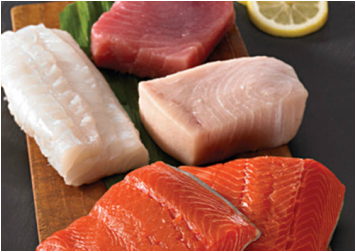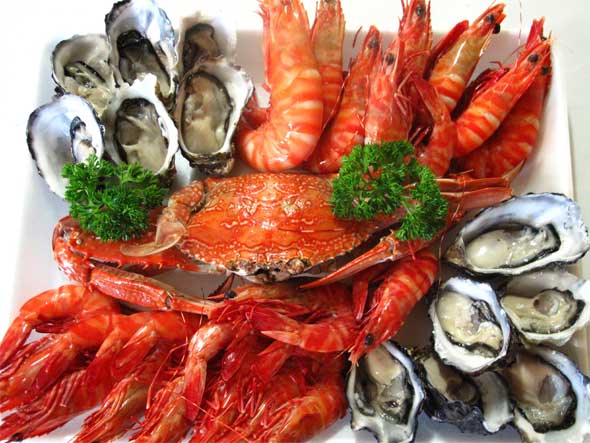When shopping for fish, look for those in the case with firm, translucent flesh. Any fish you buy should smell like the sea. Whole fish should have clear eyes, and red gills. These features mean freshness.
Texture of fish - the main difference between fish is the fat content and texture of the flesh.
- Richer fish such as salmon, mackerel, sardines, and bluefish stand up very well to aggressive flavors. Feel free to experiment with these fish by blackening or serving with sauces like curry or other aggressive flavors. They also pair well with sturdy herbs such as rosemary, cilantro, and thyme.
- Lighter, leaner fishes such as halibut, flounder, and tilapia will be overpowered by aggressive sauces. Try simply preparing these fishes with butter, lemon, and delicate herbs such as parsley, tarragon and dill.
- Sturdy, steak-like fishes such as tuna, swordfish and shark work extremely well on the grill and tend to stay intact after cooking.
- Delicate fishes like flounder, salmon, and tilapia flake when fully cooked and need to be handled with care when removing from the pan, grill, or broiler.
Note: a nice trick if you do not have a thermometer is to insert a metal skewer or pairing knife into the deepest part of the flesh and hold it there for a few seconds. Immediately remove it and test it on your lower lip or wrist like testing a baby's milk for the bottle. If the metal is lukewarm you know it is under 98.6 (body temp) If it is piping hot, it is probably done. This is how chefs did it before thermometers were commonplace in kitchens.
- Broiling: Perhaps the easiest method for fish. Season the fish with salt and pepper and any other seasonings of choice, brush with oil or butter and place on a rack under the preheated broiler. If the fish is thick cut (1 inch or thicker) set the rack lower, if the fish is very thin, set the rack closer to the broiler. With all cooking methods, the fish is done when a thermometer inserted in the deepest part of the flesh registers 145 degrees F.
- Sauteing: Extremely popular with fish. The translation from French means "to jump" which denotes the fast cooking method. A small amount of oil, butter or both is placed in a very hot pan. The fish is seasoned on both sides (sometimes dusted in flour) and cooked briefly (about 2-3 minutes) on each side. This works best with thin pieces of fish (1/2 inch and under).
- Poaching: This method uses a flavorful liquid to both season and cook the fish. This liquid can be a simple as salted water, or as complex as fish stock with white wine, lemon, herbs and peppercorns. In either case, the key to this method is that the fish is barely submerged in the liquid and that the liquid gets very hot but never comes to a full boil. If the liquid boils the fish will either break apart or overcook and become dry.
- Pan frying: This is when the level of oil reaches half way up the side of the fish. Typically the fish will be either dusted in flour or breaded with breadcrumbs. The oil should be between 350 and 375 degrees F before the fish is added to the pan. Carefully add the fish to the hot oil, always remembering to lay the fish away from your hands in the event of some splattering oil. Turn the fish when it is deeply golden brown and cook the other side to the same color. Drain on paper towels and season with salt while still warm.
- Deep frying: This is when the fish is completely submerged in the oil. The fish is usually done when it floats. Follow the same rules for pan frying for temperature seasoning.
- Pan searing or pan roasting: Very popular today on restaurant menus, this technique requires a saute pan that has an oven-proof handle. The fish is seasoned and seared very well on one side over high heat. Then the fish is flipped in the pan and the pan is transferred to a preheated oven at about 375 - 400 degrees F. This technique works very well with thick cuts such as tuna, swordfish, monkfish and salmon.
- Grilling: The key here is a lightly oiled hot grill. Season the fish well, brush with a very thin film of oil, and apply to the hot grill. Grill both sides until well charred as this is where the flavor comes from. Firm, steak-like fish are best for this application.
- Steam or boil for 7 minutes per pound.
- To broil or grill, split lobster in half lengthwise and remove the head sac (stomach) and digestive tract in the tail.
- Brush with oil, season, and grill or broil until flesh is very firm and 145 degrees F.
- Shrimp are sold by "count" which means average pieces per pound. When you see "21-25" that means that there are approximately 21-25 shrimp per pound. Therefore, the lower the number, the larger the shrimp. Cooking time will differ greatly by size as well as if you cook them in the shell or out of the shell. Shrimp in the shell take slightly longer to cook than shrimp without the shell, but retain more flavor.
Cook until the shell opens. Discard any unopened shellfish. They can be steamed, broiled, or placed directly on a grill.


 RSS Feed
RSS Feed

